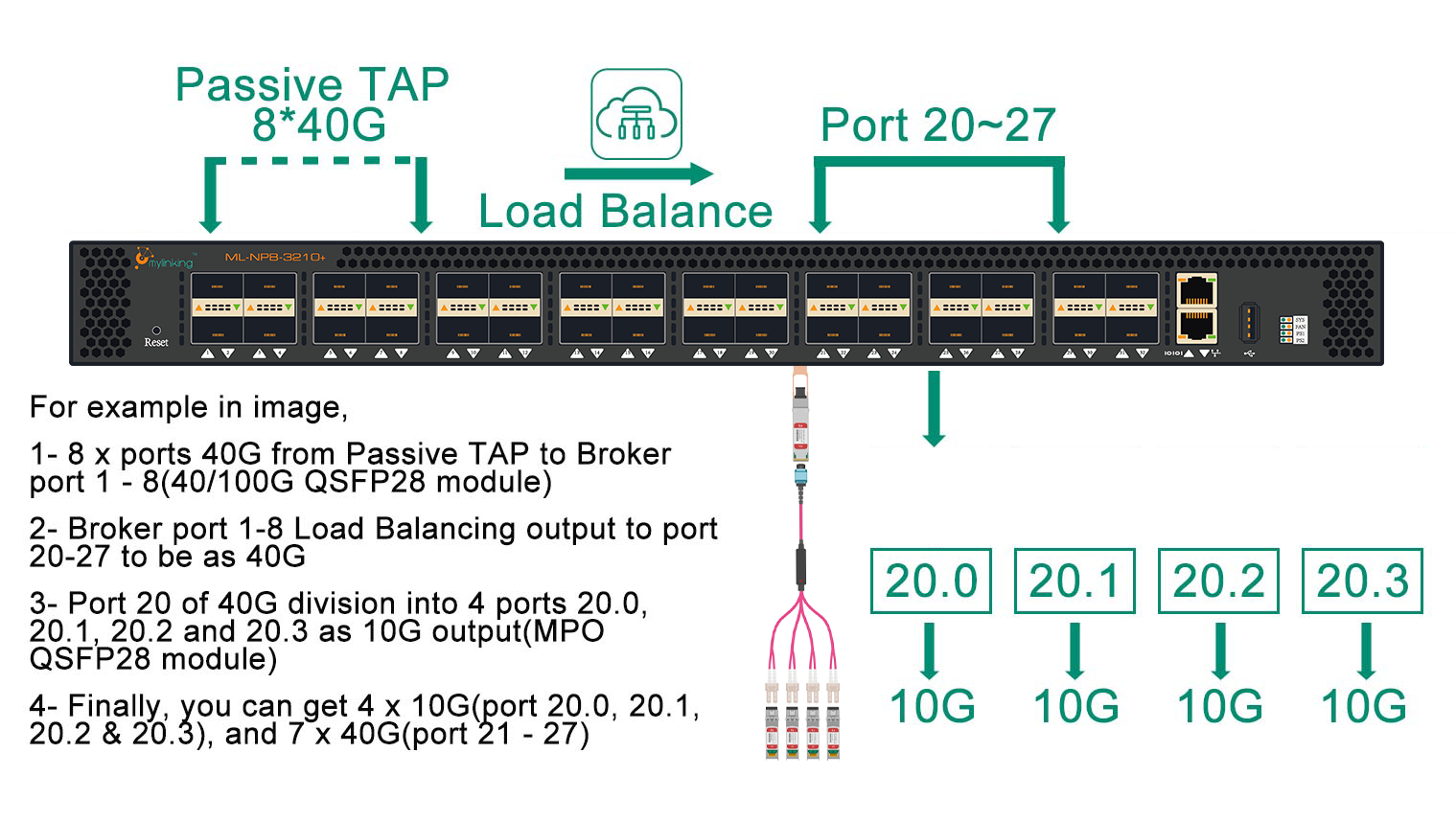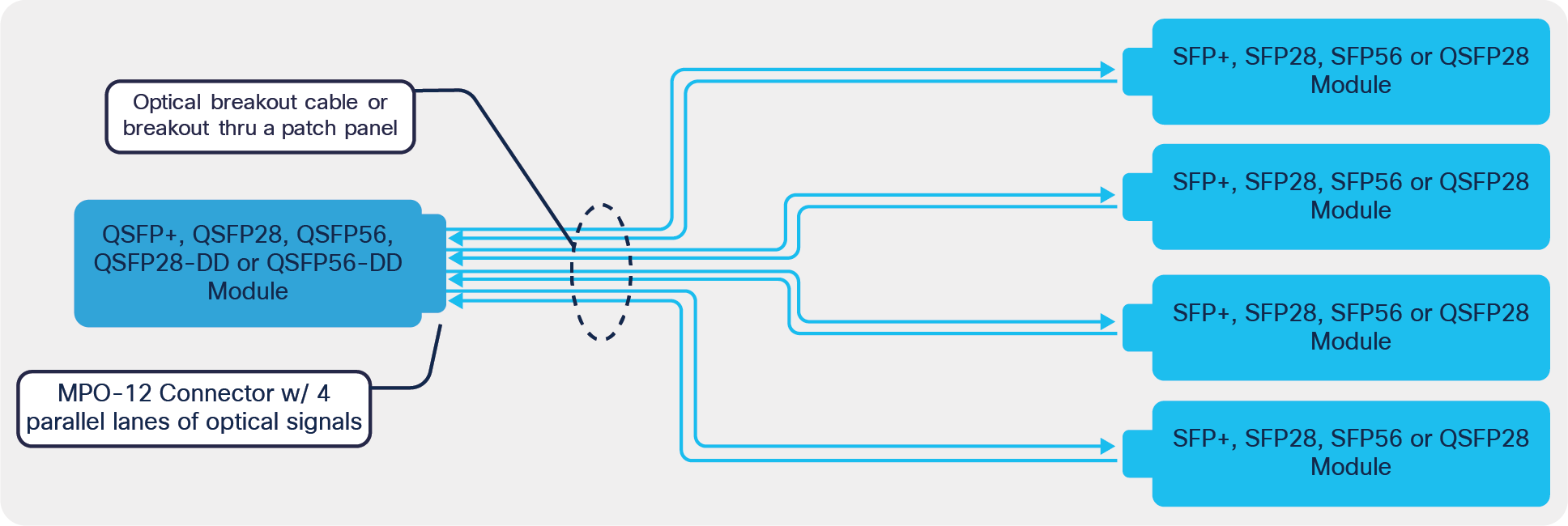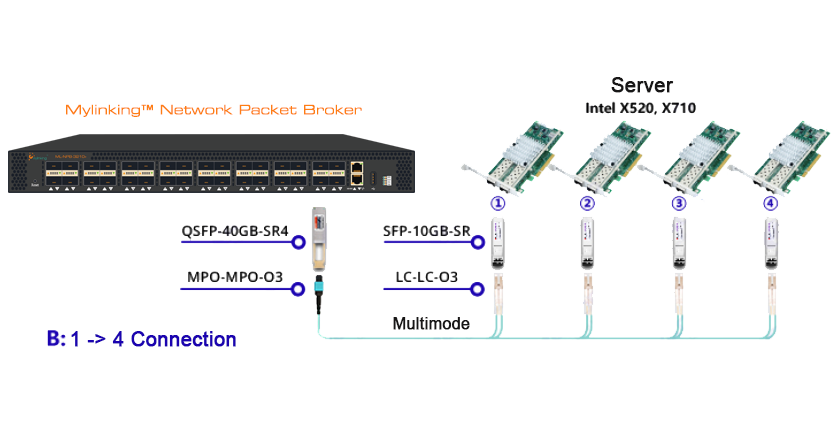Recent advancements in network connectivity using breakout mode are becoming increasingly important as new high-speed ports become available on switches, routers, Network Taps, Network Packet Brokers and other communication equipment. Breakouts allow these new ports to interface with lower-speed ports. Breakouts enable connectivity between network devices with different speed ports, while fully utilizing port bandwidth. Breakout mode on network equipment (switches, routers, and servers) opens up new ways for network operators to keep up with the pace of bandwidth demand. By adding high-speed ports that support breakout, operators can increase faceplate port density and enable upgrade to higher data rates incrementally.
What is Transceiver Module Port Breakout?
Port Breakout is a technique that allows one high-bandwidth physical interface to be split into multiple low-bandwidth independent interfaces to increase network networking flexibility and reduce costs. This technique is mainly used in networking devices such as switches, routers, Network Taps and Network Packet Brokers, where the most common scenario is to split a 100GE (100 Gigabit Ethernet) interface into multiple 25GE (25 Gigabit Ethernet) or 10GE (10 Gigabit Ethernet) interfaces. Here are some specific examples and features:
-> In the Mylinking™ Network Packet Broker(NPB) device, such as the NPB of ML-NPB-3210+, the 100GE interface can be split into four 25GE interfaces, and 40GE interface can be split into four 10GE interfaces. This port breakout pattern is particularly useful in hierarchical networking scenarios, where these low-bandwidth interfaces can be interleaved with their storage device counterparts by using the appropriate length of cable.
-> In addition to Mylinking™ Network Packet Broker(NPB) equipment, other brands of network equipment also support similar interface splitting technology. For example, some devices support breakout 100GE interfaces into 10 10GE interfaces or 4 25GE interfaces. This flexibility allows users to choose the most appropriate interface type for connection according to their needs.
-> Port Breakout not only increases the flexibility of networking, but also allows users to choose the right number of low-bandwidth interface modules according to their actual needs, thus reducing the acquisition cost.
-> When performing Port Breakout, it is necessary to pay attention to the compatibility and configuration requirements of the devices. For example, some devices may need to reconfigure the services under the split interface after upgrading their firmware to avoid traffic interruption.
In general, port splitting technology improves the adaptability and cost-effectiveness of network equipment by subdividing high-bandwidth interfaces into multiple low-bandwidth interfaces, which is a common technical means in modern network construction. In these environments, network equipment, such as switches and routers, often have a limited number of high-speed transceiver ports, such as SFP (Small Form-Factor Pluggable), SFP+, QSFP (Quad Small Form-Factor Pluggable), or QSFP+ ports. These ports are designed to accept specialized transceiver modules that enable high-speed data transmission over fiber optic or copper cables.
The Transceiver Module Port Breakout allows you to expand the number of available transceiver ports by connecting a single port to multiple breakout ports. This is particularly useful when working with a Network Packet Broker (NPB) or network monitoring solution.
Is Transceiver Module Port Breakout always available?
Breakout always involves the connection of a channelized port to multiple unchannelized or channelized ports. Channelized ports are always implemented in multilane form factors, such as QSFP+, QSFP28, QSFP56, QSFP28-DD, and QSFP56-DD. Typically, unchannelized ports are implemented in single-channel form factors, including SFP+, SFP28, and future SFP56. Some port types, such as QSFP28, can be on either side of the breakout, depending on the situation.
Today, channelized ports include 40G, 100G, 200G, 2x100G, and 400G and unchannelized ports include 10G, 25G, 50G, and 100G as shown in following:
Breakout Capable Transceivers
| Rate | Technology | Breakout Capable | Electric Lanes | Optical Lanes* |
| 10G | SFP+ | No | 10G | 10G |
| 25G | SFP28 | No | 25G | 25G |
| 40G | QSFP+ | Yes | 4x 10G | 4x10G, 2x20G |
| 50G | SFP56 | No | 50G | 50G |
| 100G | QSFP28 | Yes | 4x 25G | 100G, 4x25G, 2x50G |
| 200G | QSFP56 | Yes | 4x 50G | 4x50G |
| 2x 100G | QSFP28-DD | Yes | 2x (4x25G) | 2x (4x25G) |
| 400G | QSFP56-DD | Yes | 8x 50G | 4x 100G, 8x50G |
* Wavelengths, fibers, or both.
How Transceiver Module Port Breakout can be used with a Network Packet Broker?
1. Connection to network devices:
~ The NPB is connected to the network infrastructure, typically via high-speed transceiver ports on network switches or routers.
~ Using a Transceiver Module Port Breakout, a single transceiver port on the network device can be connected to multiple ports on the NPB, allowing the NPB to receive traffic from multiple sources.
2. Increased monitoring and analysis capacity:
~ The breakout ports on the NPB can be connected to various monitoring and analysis tools, such as network taps, network probes, or security appliances.
~ This enables the NPB to distribute the network traffic to multiple tools simultaneously, improving the overall monitoring and analysis capabilities.
3. Flexible traffic aggregation and distribution:
~ The NPB can aggregate traffic from multiple network links or devices using the breakout ports.
~ It can then distribute the aggregated traffic to the appropriate monitoring or analysis tools, optimizing the utilization of these tools and ensuring that the relevant data is delivered to the right locations.
4. Redundancy and failover:
~ In some cases, the Transceiver Module Port Breakout can be used to provide redundancy and failover capabilities.
~ If one of the breakout ports experiences an issue, the NPB can redirect the traffic to another available port, ensuring continuous monitoring and analysis.
By using Transceiver Module Port Breakout with a Network Packet Broker, network administrators and security teams can effectively scale their monitoring and analysis capabilities, optimize the utilization of their tools, and enhance the overall visibility and control over their network infrastructure.
Post time: Aug-02-2024







